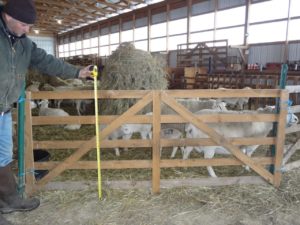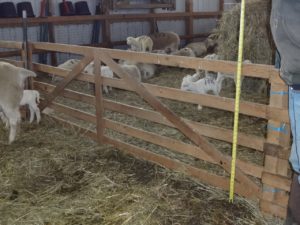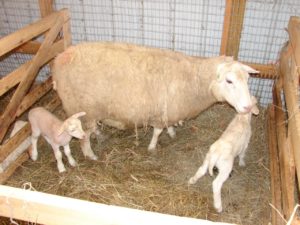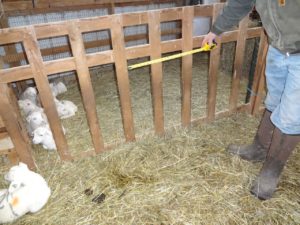Sheep Barn Interior Design: Wooden Panels
If you can handle a drill, a saw, and a few other simple tools, this article describes how to assemble panels for pens, lambing jugs, and a creep feeder.
While times change with incredible speed when it comes to the development of technology, some things seem to stand the test of time. Sheep feeders and panels were made from wood for hundreds and thousands of years. Nowadays, there is a variety of metal panels, pens, and feeders on the market, yet wooden panels seem to be the far more economical option and are perhaps even more widespread. That is if you can handle a drill, a saw, and a few other simple tools. In this article I will describe my preferences and experiences when making panels for pens, lambing jugs, and creep feeder. Feel free to copy or modify my ideas as you see fit.
The wood of choice, recommended by my friend Mahlon, a saw miller, is hemlock. Hemlock is light yet it stands pressure very well without breaking. In fact, it bends under pressure rather than breaking. The drier it is, the better it bends. The downside to hemlock is the relative ease with which it splits when you drill screws into it. So it may be necessary to pre-drill holes when putting in screws close to the edge. In the past I have also tried white pine (which works) and red oak (which is too heavy).
Any boards I use are rough cut. Other than avoiding the occasional splinter, there is no additional benefit to a finished board – rough-cut will do and is cheaper. The boards I use are one inch thick and three inches wide. Some may prefer a wider board, perhaps four or five inches wide. However, having a board thicker than one inch does not seem to suit any additional purpose. As far as the length is concerned, I go pretty much with what is available at the time in order to keep the cost low. I take anything between eight and about ten feet long. Shorter than eight feet would be too short. Boards longer than 12 feet will not be handy for one person when they are used for a panel.
In order to make my panels, I need the following tools: a circular saw, a drill, one and 5/8 inch long deck screws, a measuring tape, a woodworker’s pencil, a woodworker’s triangle, a couple of saw horses, and a make-shift work bench made from hemlock boards laid over a frame.
Length and height of the panels as well as spacing in between boards depends on the future purpose of the panels. “Normal” panels, used for making holding pens for groups of sheep, are 40 inches high and eight to ten feet long. They have five horizontal boards, the lower boards are spaced about five inches apart, the upper ones about six inches apart. My sheep are of medium size and calm disposition and the height is indeed sufficient. If your sheep are of large frame or are flighty, you may need to adjust the height accordingly. These panels have three vertical boards or “legs”, one on each end and one in the middle. Two diagonal boards create stability and keep the panel from flapping around when handled. If you wish to make these panels lamb proof, just add a sixth board and adjust the spacing accordingly. Such panels will be suitable for the chute as well.
I use pen dividers during lambing season so that I can separate a large pen to accommodate different groups, i.e. groups of sheep with lambs of different ages. These are just 36 inches high and the spacing in between the lower boards is tighter – three to four inches between lower boards and five to six inches between upper boards. The tighter spacing is because of the lambs; lambs escaping through the panel into another group is absolutely undesirable. The lower height is for me to be able to step over without the need to climb. This may sound silly but if during the course of a two to three week lambing season, you climb dozens of times per day over panels in order to get from one group to another and in and out of lambing jugs (which are of the same lower height), you will be exhausted just because of that. Stepping over is far easier. Since ewes are even less flighty during lambing and with young lambs, this height, which may be insufficient at other times, is no problem at all.
My panels for my lambing jugs or pens are of the same height and spacing as the dividers because of the same reason. The length of these panels is five feet. Due to the shorter length only one diagonal board is necessary to provide stability. These panels make a five by five jug/pen, which is sufficiently large for a ewe to bond with her lambs immediately after lambing. I set up the jugs along the wall and side by side. That reduces the need for panels per jug to two, with the need for three panels per jug on either end of this row of lambing pens.
Lastly, I also built the panels for my creep feeder myself. The spacing between vertical boards is seven inches, the height 40 inches. This allows the lambs to access the best hay I have, which is provided in a hay feeder and is inaccessible to the ewes.






a very useful article.
thank you for sharing.
Do not forget to visit my website about interior design
denah rumah minimalis
by http://denahrumahminimalismodern.com
Inspiring
Sheepfold good design, thank you for the info and article, very useful
May next I will be back for looking designrumah minimalis
sheep skin are good for clothes and bag, nice share, it’s so useful info
jasa desain interior
Interesting to read this article on the website, makes me want to always read it. thank you
I am really amazed with the wooden panels above, The interior design is inspiring.. thanks a lot.
I am really amazed with the wooden panels above, The interior design is inspiring..thanks you
How do you secure adjoining panels? If using bailing twine, what kind of knot. I can’t seem to get mine nice and snug.
good design, i would love to make this sheep design
good design, i would love to make this sheep design
Really great design. I wanna make this
Fun design! https://www.resumefalcon.ai/